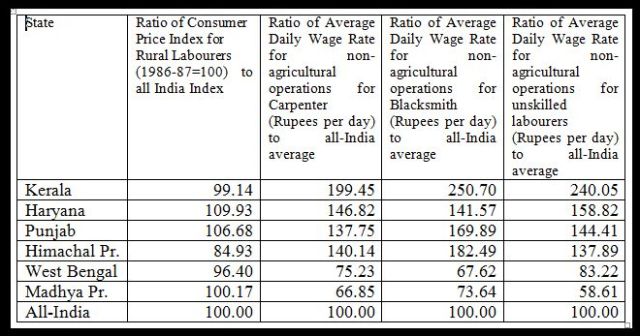Incongruity Between the Cost of Living and Average Daily Wage Rates for Non-Agricultural Workers Across Various States of India
Generally speaking, the average daily wage rates of various categories of non-agricultural workers and the consumer price index for rural labourers should be strongly correlated to each other.
It should follow that in the areas where the cost of living is higher, the wage rates should also be higher, and vice versa. With a view to looking into the behaviour of these two types of variables unto each other, data was taken from the May, 2011 issue of Indian Labour Journal.
This data depicting the Consumer Price Index for Rural Labourers (1986-87=100) for February, 2011 and the average daily wage rates for some skilled categories of rural non-agricultural workers also for February, 2011 are depicted in the following table:-

First of all, let us look at the cross State behaviour of the consumer price index for rural labourers. Indexed to the all-India average of 584, the cost of living for rural labourers is highest in Haryana at 109.93 per cent of the national average.
On the other end of the spectrum, it is lowest for Himachal Pradesh. Punjab is a close second to Haryana at 106.68 per cent followed by Maharashtra at 106.34 per cent.
Coming to the average daily wage rates for non-agricultural operations for some select categories, we would observe that the cost of living and the average daily wage rates do not exhibit a pattern of being correlated.
The all-India average daily wage rate for the category of Masons is Rs. 218.15 whereas it is highest for the State of Kerala. The cost of living indexed to all-India average for the State of Kerala is 99.14 per cent whereas the average daily wage rate indexed to all-India average for this category is 179.58 per cent.
The wage rate is lowest for Madhya Pradesh whose corresponding index comes to 70.12 per cent whereas the comparative cost of living in this State comes to 100.17 per cent. The ratio of wage rate index to cost of living index for these two States constituting the two ends of the spectrum comes to 1.81 for Kerala and 0.70 for Madhya Pradesh. This indicates towards the great disparity between these two States.
For the sake of comparison, it would be interesting to see how Himachal Pradesh stands in this spectrum. The corresponding ratio for Himachal Pradesh works out to 1.53. Similar ratios for Haryana and Punjab come to 1.44 and 1.22, respectively. Going by this data, one can conclude that workers in this category as also other categories are very well off in Kerala as compared to any other State in the country.
Their average daily wage rates are the highest whereas their average cost of living is marginally lower than the all-India average. It would be interesting to study similar indices for the State of West Bengal and compare these with Kerala. The ratio for West Bengal works out to 0.73 which is not any better as compared to Madhya Pradesh which happens to be the worst case.
The data for the same States for the categories of carpenter, blacksmith and unskilled labourers is depicted in the following table:

The above data clearly reveals that Kerala stands out as the best State in terms of the wellness coefficient (defined for the purposes of this write-up as the ratio of average daily wage rate indices to the average cost of living expressed as the consumer price index for rural labourers for various States vis-à-vis all-India figures as given in the above table).
On the other hand, for all labour intensive jobs in the non-agricultural sector, by the same implication, Kerala is the most expensive State to get the same quantum of work done as compared to any other State.
The States of Madhya Pradesh and West Bengal happen to be the States where the cost of implementation of such works will be lowest due to the wage rates being the lowest.
It would not be wrong to say that the average daily wage rates of various categories in various States do not bear a perceptible correlation to the cost of living based on the index of consumer prices for the rural labourers and have an incongruity in the pattern.
It would be more reasonable for the wages to be linked to the cost of living as is done in the case of organised employment where the increases in the cost of living are neutralized through the mechanism of dearness allowance.
It would not be all right to adopt a uniform wage structure as the conditions differ vastly but some kind of regional parity in wages would be welcome.
* : The author is a former Principal Adviser-cum-Secretary(Planning) to the Government of Himachal Pradesh.
Devinder Kumar Sharma, a former Principal Adviser and Secretary Planning, Government of Himachal Pradesh, is a visiting professor and an economist. He lives in Shimla.


